THE YEARLY READER
1901: The American League
Ban Johnson upgrades his minor league circuit to the big time and scores an impressive and colorful debut, thanks to aggressive player raids upon National League rosters.
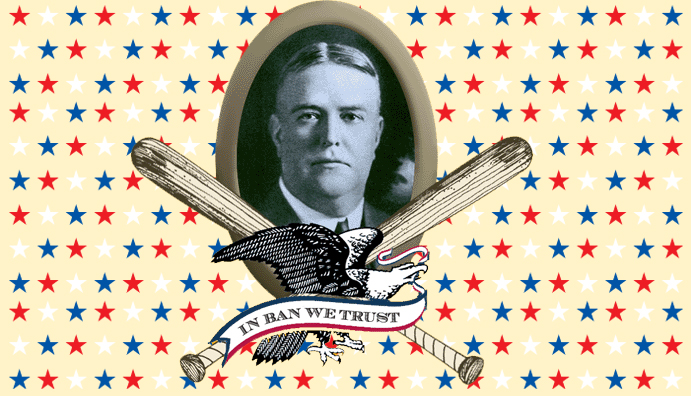
For nine full years, the National League was afforded the privilege of being unchallenged.
For nine full years, the National League was afforded the privilege of being unchallenged. Like a true monopoly, the NL’s magnates pretty much got away with whatever they wanted.
Yet the senior circuit’s corrupt arrogance was matched only by its sloppiness. As it reveled and rested in baseball’s castle of supremacy, no one was minding the watchtower, neither fearful nor aware that a possible upstart would charge forth. But little had the NL realized that, by 1893—barely two years after becoming the sole major league with the death of the American Association—the seeds had already been sown from which serious competition would sprout.
The birth of the American League, its slow and steady progress toward major league status, and its hostile arrival in 1901 as an intended equal to the NL would have a profound influence in shaping the destiny of big league baseball through the 20th Century and beyond.
Long before acquiring the unofficial title of God in the AL, Byron Bancroft “Ban” Johnson was a young Cincinnati sportswriter who loved baseball but hated its immoral attitudes. Through his columns, Johnson aggressively campaigned for a clean game where players behaved, umpires were in control, and rowdy hooligans gotten rid of. It never dawned on Johnson that he could act on his scriptures of reform by getting involved in baseball—until prodded to do so one evening at a bar with Charles Comiskey, a successful player-manager in the majors since the age of 23.
Though it was not the be-all, end-all of baseball, the Western League was a good place for Johnson to start—a minor league operation westward and wayward enough to avoid constant badgering from conniving NL owners. Johnson took over the circuit in 1893 at age 29 and quickly proved that, pound for pound—both figuratively and literally—his 300-pound presence was as powerful as his pen, passionately persuading his way to a role as league czar and instilling his doctrine of fair and clean play. Under Johnson’s rule, the WL instantly became a financial and critical hit; NL owners took notice, casually nodded and carried on with their shenanigans.
With Comiskey in tow as the head man for the WL’s St. Paul franchise, Johnson’s self-confident (if not self-righteous) stature grew to the point that he eyed self-promotion of his league from minor to major. In 1900, he fired two warning shots across the NL’s bow; he renamed his circuit the American League, and he moved Comiskey’s team to Chicago. The NL was fine with its first direct competition from Johnson in the Windy City, but only on the conditions that it retain its minor league status and play in Chicago’s filthy industrial south side without a city ID—leaving the team to be formally listed simply as the “White Stockings.” Johnson, who risked outlaw status per the sport’s National Agreement if he violated those terms, agreed. He was just happy to be in the NL’s backyard.
For 1901, Johnson removed the kid gloves and went for the kill.
Conditions were abundantly ripe for AL advancement. The NL had opened up several idle baseball markets by reducing its lineup from 12 teams to eight in 1900. Frustrated NL players had formed a union, but their owners laughed it off. Rowdyism remained rampant in the NL, enhancing Johnson’s position to sell the AL as a civilized alternative. And, most importantly, the National Agreement was set to expire—unchaining Johnson to do as he pleased without formal retribution.
BTW: Johnson quickly took advantage of one former NL city for 1900: Cleveland. Its first home game drew 6,500, more than the woebegone 1899 NL Spiders drew all year.
Johnson expanded his reach nationwide. Retaining franchises in Chicago, Detroit, Milwaukee and Cleveland, Johnson began relocating the others (Buffalo, Indianapolis, Kansas City and Minneapolis) eastward, starting with the abandoned NL markets of Baltimore and Washington. The NL, which had no use for these cities, reacted graciously in public and wished the AL good luck. But Johnson wasn’t done; he switched two more teams into the NL strongholds of Philadelphia and Boston, defiant moves that tore down the NL’s goodwill façade and sparked full-scale interleague war.
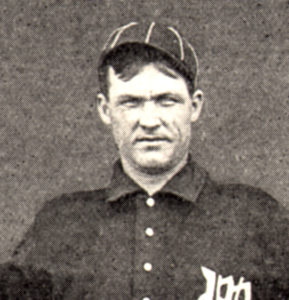
This is a caption.
Johnson’s command, bravado and experience were enough to convince NL superstars and common players alike that the AL was worth the risk. And so they came: Cy Young, Jimmy Collins, Nap Lajoie, John McGraw, Mike Donlin, Joe McGinnity, Clark Griffith and Hugh Duffy, among many, many others. When the Opening Day rosters were set for 1901, nearly two-thirds of all American Leaguers were NL veterans.
Others were highly tempted but decided to stick with the NL’s relative fear of the known. One such player was young yet highly touted pitcher Christy Mathewson, who had signed with the AL’s Philadelphia Athletics—he even received an advance—before developing cold feet and returning to the New York Giants.
BTW: Philadelphia manager and minority owner Connie Mack considered suing Mathewson, but ultimately decided against it.
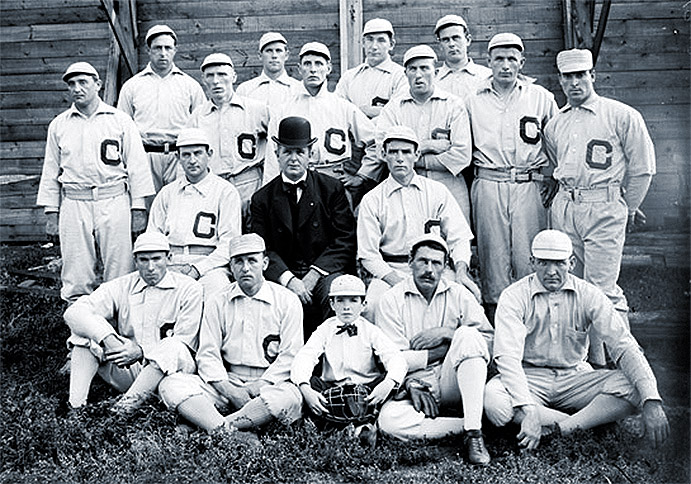
A portrait of the Chicago White Stockings, owners of the AL’s first pennant. Seated in the middle in top hat and suit is manager-owner Charles Comiskey, Ban Johnson’s right-hand man. (Library of Congress)
The Chicago White Stockings clearly set the pace for the AL’s debut as a major circuit, winning the league’s first-ever game—April 24 over the Cleveland Blues, 8-2—and its first-ever pennant. (Three other AL games scheduled for April 24 were rained out.) The team once managed and now owned by Charles Comiskey grabbed first place the way they often would throughout its early existence: With pitching, speed and very little hitting. Buffeted by the pitching (and managing) of veteran ace Clark Griffith (24 wins, seven losses and a 2.67 earned run average) and the rookie presence of Roy Patterson (20-16, 3.37), the White Stockings overcame a mid-season rally from the Boston Americans to win the AL flag by four games.
The range of talent throughout the AL, one that mixed all-stars with veterans and career minor leaguers who slipped through the cracks, firmly suggested that there was some fleshing out needed to develop a consistent level of play. Two storied players would especially take advantage of the talent imbalance and feast upon the AL.
Cy Young set out to prove that his former employer, St. Louis Cardinals owner Frank Robison, was wrong to assume that the 34-year-old pitcher was at the end of the line. Given a three-year contract by the AL’s Boston Americans after Robison offered only a one-year deal, the quiet, masterful Young shut down the opposition with a 33-10 record, 1.62 ERA and just 37 walks allowed in a prodigious 371.1 innings. That was the good news for Boston. Here was the better news: Young was settling in, not down as Robison had predicted.
Washed Up? Watch This
Cy Young’s remarkable durability led to his standing as the modern era’s winningest pitcher after turning 34—an age ridiculed by Young’s former NL employers in St. Louis as being over-the-hill.
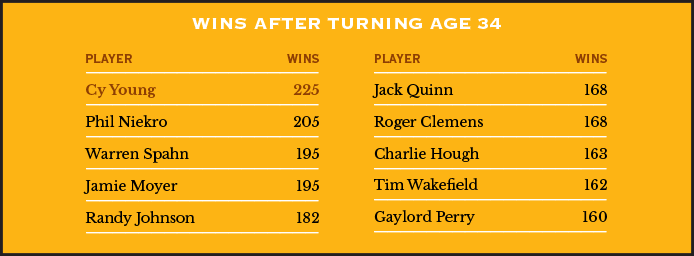
As Young stood head and shoulders among AL pitchers, he found an equal among the hitters in Nap Lajoie. A 26-year-old Rhode Island native with a tightly-packed, muscular physique worthy of Adonis, Lajoie decimated the competition for the Philadelphia Athletics with a triple crown performance—batting a 20th Century-high .426 with 14 home runs and 125 runs batted in. The Baltimore Orioles’ Mike Donlin finished second in the AL batting race behind Lajoie—by a full 86 points. Lajoie’s crushing performance helped the Athletics rebound from a mediocre start to a respectable fourth-place finish, nine games back of the White Stockings.
BTW: Lajoie’s .426 average remains a point of contention; some sources list him at .422, while others debate the relative sanctity of an average accomplished when foul balls were not counted as strikes.
Although Ban Johnson succeeded in acquiring National League players in bulk, he also inherited whatever on-field roguery they brought with them. The American Leaguers behaved for the first half of the year in accordance with Johnson’s decree to do away with the game’s uncivilized elements. But by mid-summer a number of players, perhaps assuming Johnson had been bluffing all along with his pledge to clean up the game, reverted to their old ways. Those who took the risk paid dearly. Baltimore’s Bret Hart and Chicago’s Frank Shugart punched out umpires in separate incidents—and quickly got kicked out of the AL; neither would play again in the majors. Joe McGinnity, the tireless ace of the Orioles’ staff, also received an expulsion notice after spitting at another umpire—and had to all but beg on his knees for reinstatement. Johnson, in a rare case of forgiveness, gave it to him.
In the end, the AL held its own against the NL. Attendance checked in at 3,100 per game, not far behind the NL’s average of 3,500. More importantly, in the three cities where the two leagues rammed head-to-head, the AL scored a technical knockout. The AL outdrew its NL competition two-to-one not only in Chicago but in Boston, the latter city a stunning case of a first-year AL franchise outdrawing a once proud NL franchise in the Beaneaters—who in desperation slashed admission prices in half during the season in a vain attempt to win back their fans. Only in Philadelphia did the NL hold firm—but barely, as the AL’s Athletics proved their worth to their crosstown NL rival in the Phillies with an almost equal gate.
BTW: The Americans were impressive enough to make converts out of the Royal Rooters, a band of enthusiastic Irish fans who had been following the Beaneaters.
On the field as well as at the turnstiles, the National League remained the better of the two leagues for the moment, in spite of the players’ mass defections to the AL. And while most NL teams shared the pain of the talent drain, the NL pennant would be easily captured by the one team virtually unaffected by AL encroachment: The Pittsburgh Pirates.
Most of the hard work that enabled the Pirates to win the first pennant in their 20-year history was actually done before, not during, the 1901 season, as Pirates owner Barney Dreyfuss fought battles on two fronts. One battle was internal; after buying half-interest in the Pirates a year earlier, Dreyfuss emerged successfully from a bitter, off-season power struggle to get the other half from his equally hostile co-owner, William Kerr. The other battle was external; Ban Johnson and his AL spies zealously tried to lure Pittsburgh superstar Honus Wagner away, but Dreyfuss just as fervently wedged himself in to prevent it. Wagner remained anyway, content to stay the course in the more established NL even as the AL offered more money.
Now solely in charge upstairs, Dreyfuss watched as the Pirates took first place in mid-June and never gave it back, taking the NL flag by seven games. Wagner stayed put and continued his offensive dominance, batting .353 and leading the NL with 126 RBIs and 49 steals. Just as fearsome to opponents was the Bucs’ starting rotation, featuring three right-handers in Deacon Phillippe (22-12, 2.22 ERA), Jack Chesbro (21-10, 2.38), Sam Leever (14-5, 2.86) and a southpaw Jesse Tannehill (18-10, 2.18) who put together the league’s best ERA.
What Defection Hath Wrought
The American League’s initial raids upon the National League shifted the senior circuit’s balance of power—though it wasn’t necessarily a clear-cut example of the most affected teams sinking in the standings, as shown below.
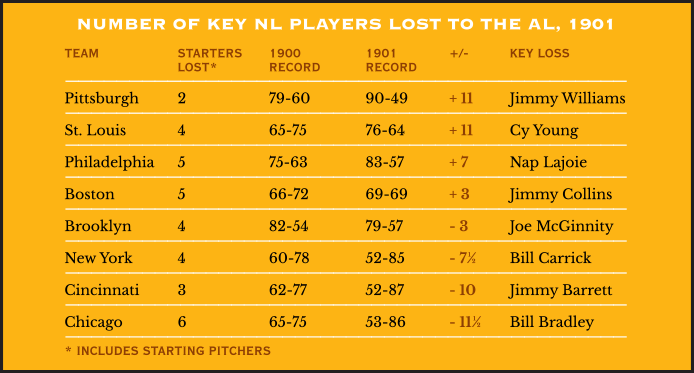
For the time being, the idea of a postseason series between the two leagues remained as distant as Neptune. The American League, relishing over its solid major league debut, might have been up for it—but it held no illusions that the National League would embrace this exultant new kid on the block.
War would rage into the coming offseason with a new round of player raids—not just by the AL, but also by a vengeful NL. Meanwhile, a salivating and hardly content Ban Johnson readied to invade more NL markets. It was just a matter of time before the lawyers got involved.
Thanks to the American League’s entrance onto the big league stage, baseball was alive again. Fans had more choices. Players took advantage of competitive bidding to receive long-overdue wage increases. Even the owners, with all their money being poured out to retain and acquire new players, would eventually get it and comprehend their own positives.
The monopoly party may have been over for the National League’s magnates, but in its place was a healthy atmosphere of competition that forced them to get off their cans and put out a top-flight product.
Because if they didn’t, someone over in the other league would.
 Forward to 1902: Enemies Within the Gate Warfare between the American and National Leagues turns brutal with increased player raids and sabotage.
Forward to 1902: Enemies Within the Gate Warfare between the American and National Leagues turns brutal with increased player raids and sabotage.
 Back to 1900: On the Brink of Adulthood The monopolistic National League lumbers into the 20th Century by continuing its self-served sleepwalk a year before the American League is forced to wake it up.
Back to 1900: On the Brink of Adulthood The monopolistic National League lumbers into the 20th Century by continuing its self-served sleepwalk a year before the American League is forced to wake it up.
 1901 Leaders & Honors Our list of baseball’s top 10 hitters and pitchers in both the American League and National League for the 1901 baseball season, as well as the awards and honors given to the game’s top achievers of the year.
1901 Leaders & Honors Our list of baseball’s top 10 hitters and pitchers in both the American League and National League for the 1901 baseball season, as well as the awards and honors given to the game’s top achievers of the year.
 The 1900s: Birth of the Modern Age The established National League and upstart American League battle it out, then make peace to signal in a new and lasting era.
The 1900s: Birth of the Modern Age The established National League and upstart American League battle it out, then make peace to signal in a new and lasting era.



